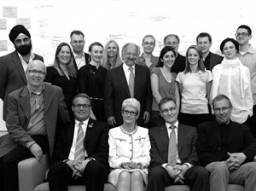An elderly person also faces an array of options concerning the social fabric and service networks they will be connected to—who provides the care and services for their well-being? The primary support sources are provided by institutional systems, from independent social networks, or a hybrid situation such as a home care system. These systems will determine an elderly person’s social context and service environment. These options are combined with the different physical environments above for a range of possible permutations.
Home Care
An elderly person who lives independently is still able to receive a range of different services and nursing care through the home care system. Care available at home ranges from yearly preventive visits to daily procedural visits. As of 2004, 10.6% of people over sixty-five living outside of institutions received some form of daily assistance within the home (with 3.6% receiving 24-hour care), while 74.8% received little to no help at all (Health in Finland 55, figures reported on the male population, but those for women are similar, though slightly lower). Assistance fall into a number of different categories, which are based on the type and scope of services provided.
The government has typically made a distinction between home services and home nursing (which are now merging under the umbrella concept of home care) primarily based on the level of the qualifications of the service providers. “Nursing” may include technical medical assistance and mental or physical rehabilitation, while “Services” might include meals-on-wheels, transportation, or laundry and cleaning services. In addition to these services, there are other “day services” that include programmemed activities aimed at encouraging social interaction or exercise.
Social Networks and Informal Care
In addition to governmental home care services, an elderly person living alone or with family might receive more informal types of assistance from their surrounding community and social network. Assistance at varying levels of formality might be provided by family members, the community, volunteers, or even private organizations. If an elderly person lives with others or has caretakers, care services may be financed by the government through informal care allowances. For those elderly living at home, the government offers different types of assistance in order to encourage independence and self-sufficiency.
In addition to different types of direct assistance, the government tries provide access to indirect assistance in the form of renovation grants, which may be applied to home modifications that are better adapted to accommodate physical needs, or informal care support allowances for family members or others who are assisting in the care of an elderly person living at home. As of 2007, approximately 3.9% of the population above seventy-five was receiving informal care support, and this number is currently increasing with a government target of 5-6% by 2012 (Statistical Yearbook).
Institutional Care
In institutional facilities, care and services are part of a total environment design; A resident will receive the care and services they need, most of the time on-site. At health centres and specialized facilities that operate like hospitals, daily medical care structures dominate a resident’s routine, with less emphasis placed on engaging the social components of an elderly resident’s life. The services in such facilities are usually determined to first address direct medical concerns, with softer, social criteria as secondary concerns. Depression and loss of appetite are the sorts of general health decline experienced by residents, conditions which may be the result of general complaints from residents in such facilities. These complaints may include stifling routines, inconsistent caregivers, and isolation from meaningful social networks.
In a typical nursing home, while residents have individual rooms and receive individual care, they also spend their time in common spaces, dine together, cohabiting and sharing services with those of similar functional capacity. Medical care is integrated into daily routines accordingly: residents are encouraged to choose and prepare their own meals, determine their own schedules, and participate in activities as they choose; residents with dementia often live in more controlled environments with more structured care.
It is the general philosophy of the more progressive facilities to use care and service delivery as an opportunity to encourage independence and self-sufficiency in the residents. At such institutions, nurses are encouraged to propose their own small innovations in helping residents improve their functioning, increase daily enjoyment, and maintain their independence, daily routines, habits and level of comfort in a manner similar to what they experienced at home. These procedures are then shared among nurses for bottom-up development, while simultaneous top-down procedures are implemented.
In nursing homes, where common spaces are open to residents, a dining facility might be open to the public, allowing guests and residents to dine together, and be designed like a restaurant so as to encourage some level of integration between the institution and the surrounding community. Residents may also receive taxi subsidies or participate in group activities, such as shopping or museum visits.
Such principals and practices reflect a general attempt at making the nursing home experience in Finland as similar to home living and home care as much as possible. It is generally believed that home care is the ideal solution for an elderly person. Hope of returning home at some point, however wishful, is one of the driving sentiments in the nursing home environment.
Hybrid Care
Sheltered housing (both daily and 24-hour) combine the independence and social network connections supported by home care with the inclusive, structured environments of nursing homes and other similar institutions. It provides a suite of inclusive services in an environment that is intended to be more reminiscent of a resident’s previous house or apartment and feel less like an institution, and as such is more integrated with the surrounding built and social environments.
This hybrid condition takes on the form of differentiated groups of appropriate apartments clustered by care needs and embedded in a flex- ible service network. Services and experiences are in line with those of home care, with residents receiving a customized suite of services in an independent apartment that is both tailored to individual needs and well-integrated with the surrounding area. This relatively new type of elder care environment remains somewhat loosely defined, and is still developing as a service and care archetype.
Source: HDL Challenge Briefing on Ageing 1.0

